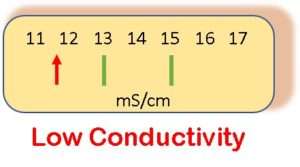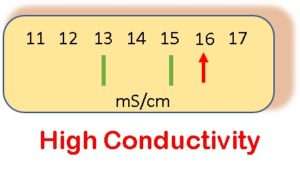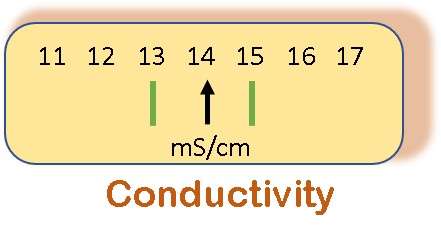Introduction
Conductivity (CD) is a measurement of the ability of the total ionic content of dialysate to conduct electricity.
- It depends on the concentration of the ions, the additivity of the ionic contributions (anions and cations added together) and the type of ions present.
- CD measurement is an important safety feature.
- It is measured in mili Siemens/centimeter (mS/cm).
- Since salt in an aqueous solution can conduct electricity very well, this means for the dialysis fluid: the higher the conductivity, the greater the electrolyte concentration in the dialysis solution. Its value increases with the number of electrolytes dissolved in the dialysis solution.
- When electrolytes add to the dialysis solution, the molecules break down into their ions and electrons.
- Measuring electrodes record the total number of ions/electrons and display the conductivity in mili Siemens (mS).
- Modern dialysis machines have many CD measuring cells acting as transducers, protection systems or control systems.
- Since the dialysis fluid contains different electrolytes in varying concentrations, the total conductivity cannot use to determine the individual salt concentration. The total CD is, therefore, directly proportional to the total amount of salt dissolved in the fluid (total ion concentration).
- Hemodialysis machine uses temperature compensated conductivity cell to measure it.
- The measuring range of CD is 12 to16 mS/cm.
Importance of CD
- An incorrect electrolyte concentration in the dialysis fluid can lead to a life-threatening situation for the patient.
- The measurement of the CD of the dialysis fluid serves as a protective system.
- The electrical CD is a physical quantity that indicates the ability of a substance to conduct an electrical current.
Conductivity and Temperature
- The conductivity is temperature-dependent.
- CD increases by approx. 2%/˚C, depending on the aqueous solution measured.
- For this reason, the measuring systems of the hemodialysis machines are temperature compensated.
- Therefore, the CD would also change when the dialysate temperature changes and vice versa.
- The temperature compensation counteracts this effect and keeps the conductivity constant regardless of the temperature present.
- The temperature compensation values of the various manufacturers differ slightly since each uses a different solution with ions and cations to determine the compensation value.
- Unfortunately, different machines can have slightly different CD readings with the same basic settings.
Low Conductivity
The concentrate supply is usually interrupted if the CD drops rapidly. The hemodialysis machine switches to the bypass, but the blood pump continues. In dialysis patients, low dialysate CD may improve outcomes relatively to reduce the overall sodium burden.

The reasons for the low conductivity alarm are:
- No concentrate supplies
- Air in acid or bicarbonate line
- Proportioning pump running too slow (technical defect)
- Concentrate setting incorrect
You can solve the low conductivity alarm with the following measures.
- Connect the concentrate line to the system
- Check for kinks in the concentrate line
- Change the concentrate canister if it is empty
- Check the concentrate line if it drops into the canister properly
- Should try a different machine if there is a technical defect
- Make sure that the setting of concentrate is in range
High Conductivity

The reasons for the high conductivity alarm are:
- Proportioning pump running too fast (technical defect)
- Acid or bicarbonate do not mix well
- Concentrate setting incorrect
- Untreated incoming water
- Interruption in water supply
The following solutions could be helpful for the high conductivity alarm.
- Should try a different machine
- Check for kink in the concentrate line
- Make sure that the setting of concentrate is in range
- Check the water treatment system
- Check to see if water is flowing too slowly or turn off
References
- Bertinsson, G.I. (2012), The Conductivity of Dialysis Fluid. EDTNA-ERCA Journal: Vol 31, Pages: 31 – 34. https://doi.org/10.1111/j.1755-6686.2005.tb00387.x
- Petitclerc, T. (2006), Do dialysate conductivity measurements provide conductivity clearance or ionic dialysance?. Kidney International: Volume 70, Issue 10, Pages 1682-1686
- http://apexkidneyfoundation.org/uploads/knowledgebase/files/ds2019_010_Sudhir%20.pdf
- https://www.k-space.org/Class_Info/EE497/KAU_Hemodialysis_lec.pdf
- https://www.dialysistech.net/images/Is%20the%20Patient%20Receiving%20Treatment%20as%20Prescribed%20-%20Johnson.pdf

